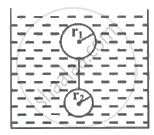Advertisements
Advertisements
Question
A piece of wood is taken deep inside a long column of water and released. It will move up
Options
with a constant upward acceleration
with a decreasing upward acceleration
with a deceleration
with a uniform velocity
Solution
The density of wood is less than that of water.When a piece of wood is immersed deep inside a long column of water and released, it experiences a buoyant force that gives it an upward acceleration. The velocity of wood increases as its motion is accelerated by the buoyant force. However, the viscous drag force acts simultaneously to oppose its upward motion. As a result, the initial acceleration decreases and the wood rises with a decreasing upward acceleration.
APPEARS IN
RELATED QUESTIONS
A solid sphere falls with a terminal velocity of 20 m s−1 in air. If it is allowed to fall in vacuum,
A solid sphere moves at a terminal velocity of 20 m s−1 in air at a place where g = 9.8 m s−2. The sphere is taken in a gravity-free hall having air at the same pressure and pushed down at a speed of 20 m s−1.
(a) Its initial acceleration will be 9.8 m s−2 downward.
(b) It initial acceleration will be 9.8 m s−2 upward.
(c) The magnitude of acceleration will decrease as the time passes.
(d) It will eventually stop
Two spheres of equal masses but radii r1 and r2 are allowed to fall in a liquid of infinite column. The ratio of their terminal velocities are ____________.
A drop of radius 1.5 x 10-5 and density 2 x 103 kg/m3 falls through air. The viscosity of air is 1.8 x 10-5 N s/m2. Neglecting buoyancy due to air, the terminal speed of the drop is ____________.
A drop of radius 4 x 10-5 m and density 2.5 x 103 kg/m3 falls through air. The viscosity of air is 1.96 x 10-5 N s/m2 . Neglecting buoyancy due to air, the terminal speed of the drop is ____________.
Two small spherical metal balls, having equal masses, are made from materials of densities `rho_1` and`rho_2 (rho_1 = 8rho_2)` and have radii of 1 mm and 2 mm, respectively, they are made to fall vertically (from rest) in a viscous medium whose coefficient of viscosity equals `eta` and whose density is `0.1rho_2` The ratio of their terminal velocities would be, ____________.
Eight identical drops of water falling through air with uniform velocity of 10 cm/s combine to form a single drop of big size, then terminal velocity of the big drop will be ______.
The radii of the two spheres P and Q of same material falling in the viscous liquid are in the ratio 3 : 2, their terminal velocities (P to Q) are in the ratio ______.
A small spherical solid ball is dropped from a great height in a viscous liquid. Its journey in the liquid is best described in the diagram given below by the ____________.

A small metal ball of mass 'm' is dropped in a liquid contained in a vessel, attains a terminal velocity 'v'. If a metal ball of same material but of mass '8m' is dropped in same liquid then the terminal velocity will be ____________.
Two drops of equal size are falling vertically through the air with a constant terminal velocity of 0.15 cm/s. What should be the velocity, if these drops coalesce to form one drop?
A small spherical ball of radius 0.1 mm and density 104 kg m-3 falls freely under gravity through a distance of h before entering a tank of water. If, after entering the water the velocity of the ball does not change and it continues to fall with the same constant velocity inside the water, then the value of h will be ______ m.
(Given g = 10 ms-2, the viscosity of water = 1.0 × 10-5 N-sm-2).
Two solid spherical balls of radius r1 and r2 (r2 < r1), of density σ are tied up with a long string and released in a viscous liquid column of lesser density ρ and coefficient of viscosity η, with the string just taut as shown. The terminal velocity of spheres is ______.

A spherical ball of iron of radius 2 mm is falling through a column of glycerine. If densities of glycerine and iron are respectively 1.3 × 103 kg/m3 and 8 × 103 kg/m3. η for glycerine = 0.83 Nm-2 sec, then the terminal velocity is ______.
Two equal drops of water are falling through air with a steady velocity v. If the drops coalesce, the new velocity will be ______.
